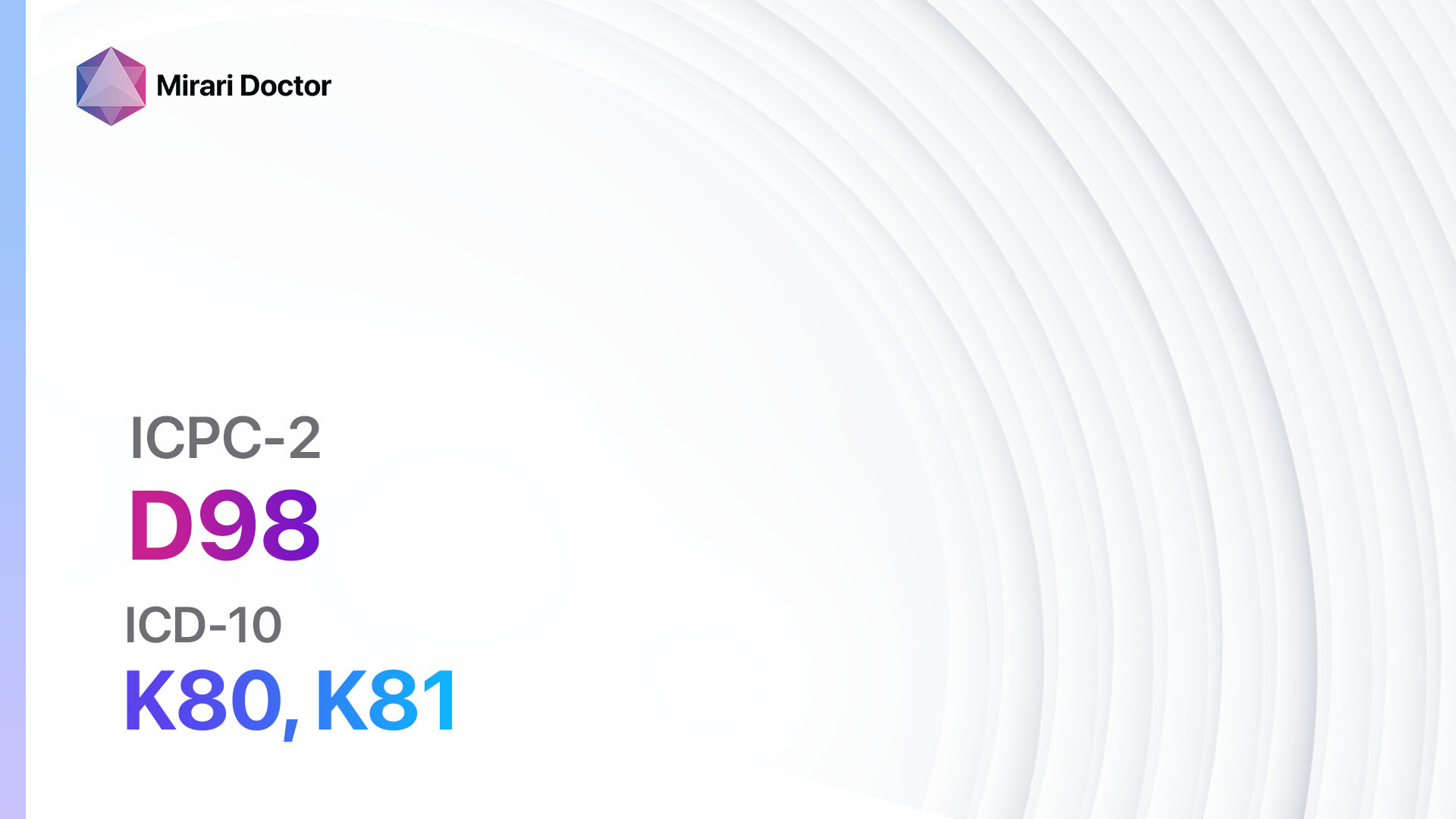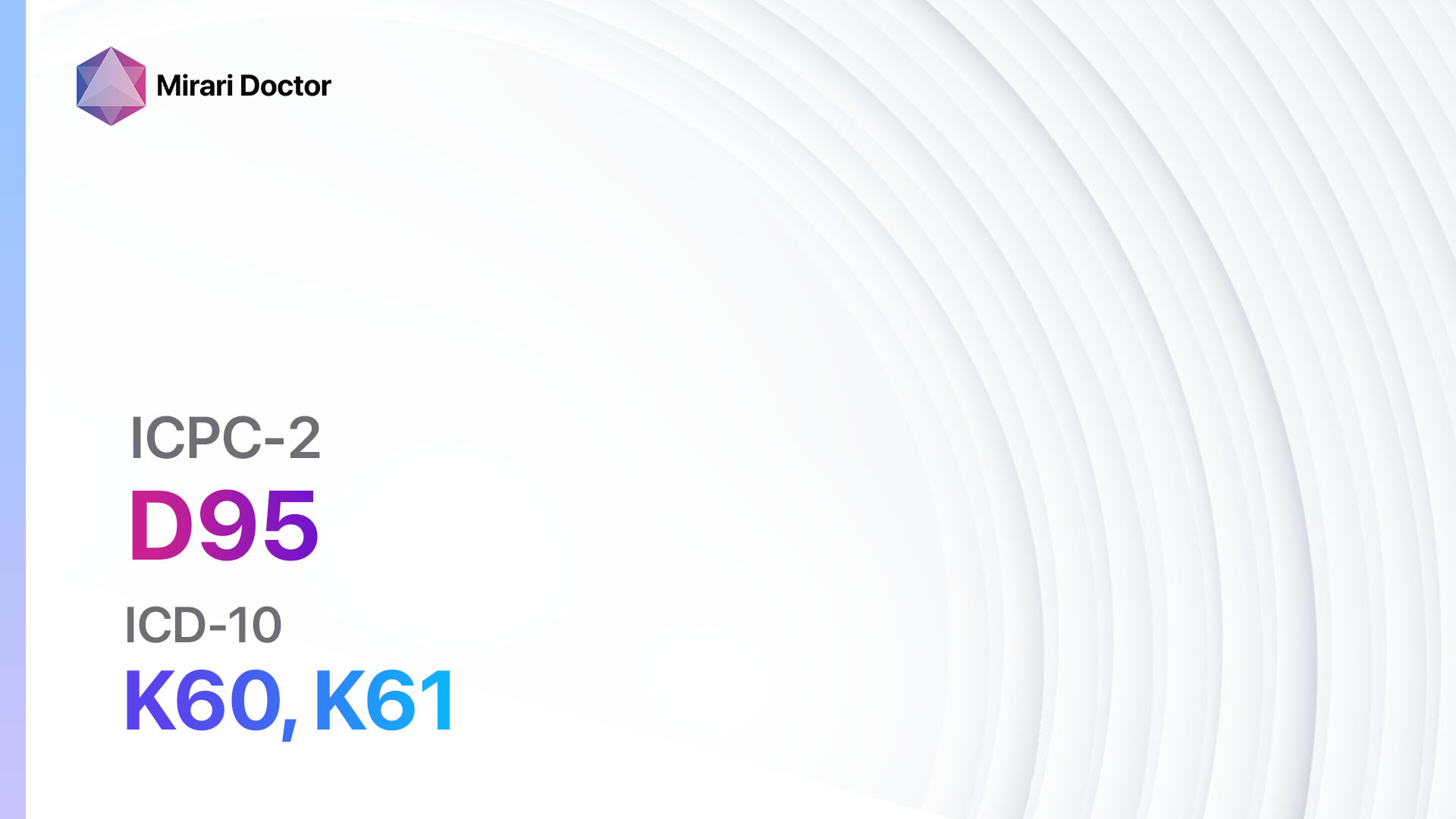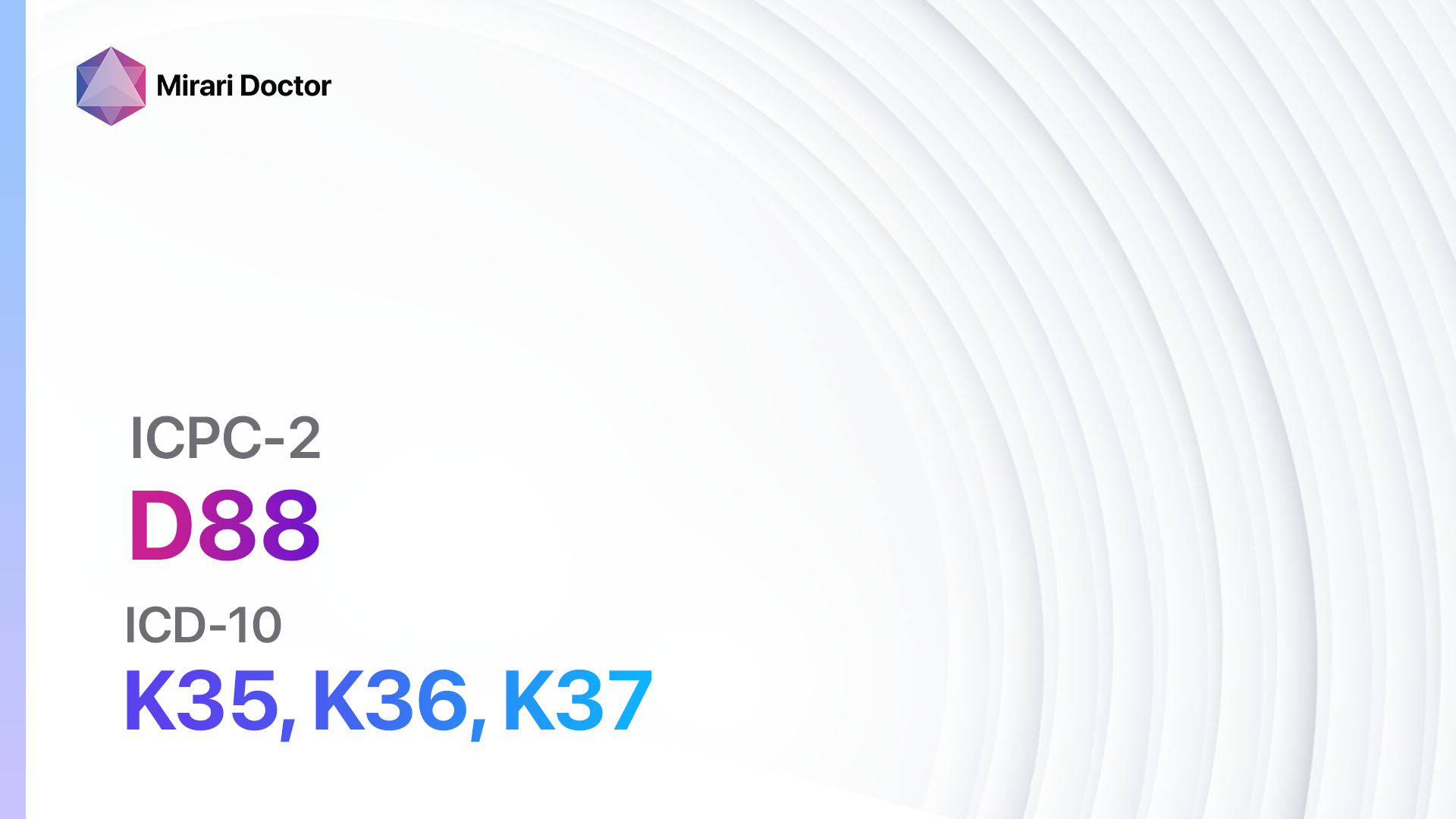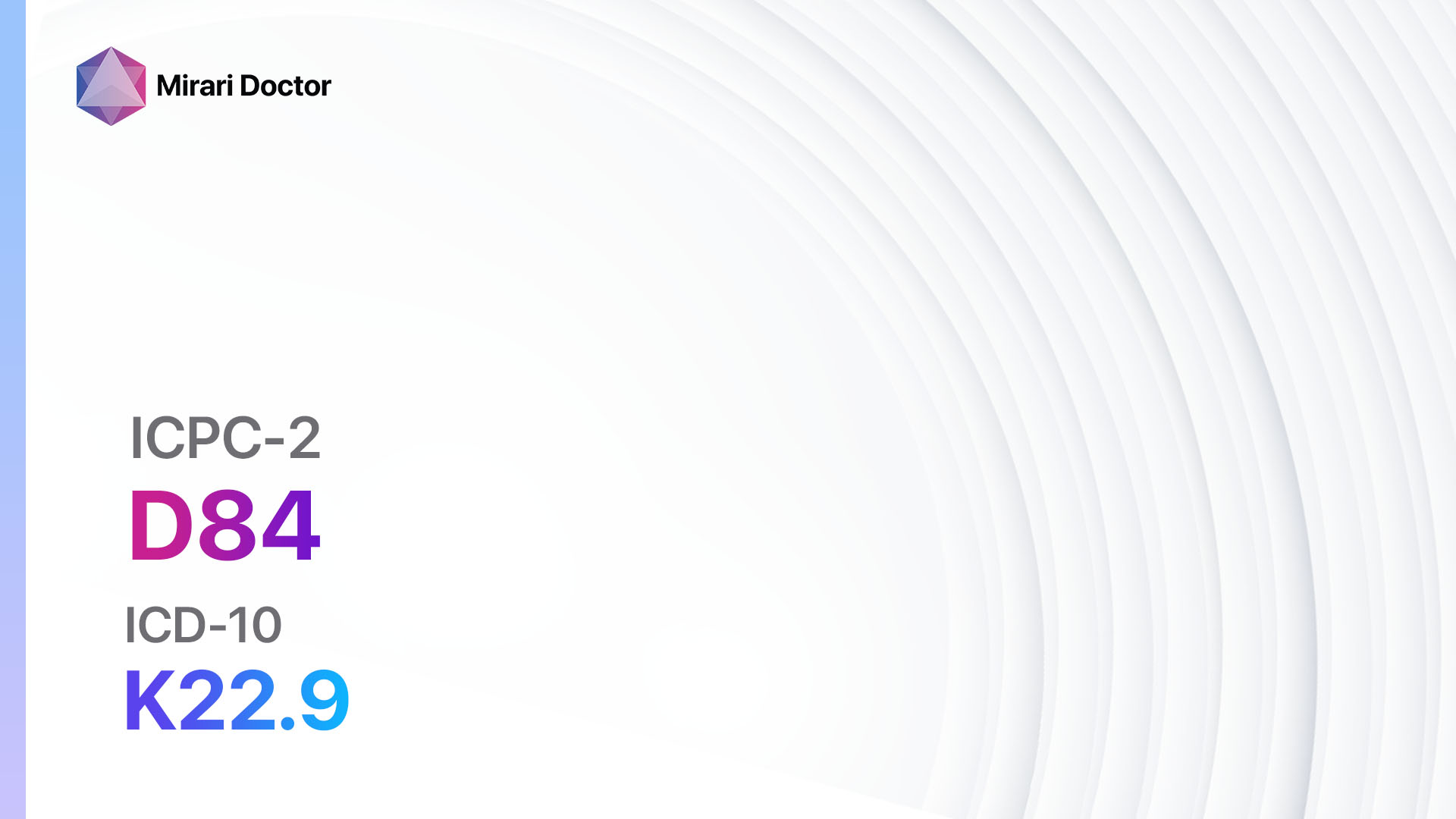
Introduction
Abdominal pain localized other refers to abdominal pain that is not associated with any specific organ or condition. It is a common symptom that can be caused by a variety of factors[1]. The aim of this guide is to provide a comprehensive overview of the diagnostic steps and possible interventions for abdominal pain localized other.
Codes
- ICPC-2 Code: D06 Abdominal pain localized other[2]
- ICD-10 Code: R10.3 Pain localized to other parts of lower abdomen, R10.4 Other and unspecified abdominal pain[3][4]
Symptoms
- Abdominal discomfort or pain
- Cramping or sharp pain in the abdomen
- Bloating or feeling of fullness
- Nausea or vomiting
- Changes in bowel movements (diarrhea or constipation)[5]
Causes
- Irritable bowel syndrome (IBS)
- Functional dyspepsia
- Gastroenteritis
- Gastric ulcers
- Gallstones[6]
Diagnostic Steps
Medical History
- Gather information about the patient’s symptoms, including the location, duration, and severity of the abdominal pain.
- Ask about any associated symptoms, such as changes in bowel movements or nausea.
- Inquire about any previous medical conditions or surgeries that may be relevant.
- Assess for any risk factors, such as a family history of gastrointestinal disorders or a history of certain medications.[7]
Physical Examination
- Perform a thorough physical examination, including palpation of the abdomen to assess for tenderness or masses.
- Check for any signs of inflammation, such as redness or swelling.
- Listen for bowel sounds to evaluate gastrointestinal motility.
- Assess vital signs, including blood pressure, heart rate, and temperature.[8]
Laboratory Tests
- Complete blood count (CBC) to check for signs of infection or inflammation.
- Comprehensive metabolic panel (CMP) to assess liver and kidney function.
- Stool culture to rule out bacterial or parasitic infections.
- Celiac disease panel to test for gluten intolerance.
- Helicobacter pylori test to check for the presence of H. pylori bacteria.[9]
Diagnostic Imaging
- Abdominal ultrasound to visualize the organs in the abdomen and assess for any abnormalities.
- Computed tomography (CT) scan to obtain detailed images of the abdomen and identify any structural abnormalities.
- Magnetic resonance imaging (MRI) to evaluate the abdominal organs and blood vessels.
- Upper gastrointestinal (GI) series to examine the upper digestive tract using contrast material.
- Colonoscopy or sigmoidoscopy to visualize the colon and rectum and detect any abnormalities.[10]
Other Tests
- Endoscopy to examine the esophagus, stomach, and upper small intestine.
- HIDA scan to evaluate the function of the gallbladder and bile ducts.
- Gastric emptying study to assess the rate at which food leaves the stomach.
- Breath test to detect bacterial overgrowth in the small intestine.
- Capsule endoscopy to visualize the small intestine using a swallowed capsule with a camera.
Follow-up and Patient Education
- Schedule a follow-up appointment to review the results of the diagnostic tests and discuss further treatment options.
- Provide patient education materials on lifestyle modifications and self-care strategies to manage abdominal pain.
- Encourage the patient to keep a symptom diary to track the frequency and severity of abdominal pain.
Possible Interventions
Traditional Interventions
Medications:
Top 5 drugs for Abdominal pain localized other:
- Antacids (e.g., Maalox, Mylanta):
- Cost: $5-$15 for a bottle of antacid tablets or liquid.
- Contraindications: Allergy to antacids or any of its components.
- Side effects: Constipation or diarrhea.
- Severe side effects: Rare, but may include allergic reactions or electrolyte imbalances.
- Drug interactions: May interact with certain antibiotics or antifungal medications.
- Warning: Do not take antacids for more than two weeks without consulting a healthcare provider.
- Proton pump inhibitors (e.g., Omeprazole, Esomeprazole):
- Cost: $10-$30 for a month’s supply of generic medication.
- Contraindications: Allergy to proton pump inhibitors or any of its components.
- Side effects: Headache, diarrhea, or abdominal pain.
- Severe side effects: Rare, but may include severe allergic reactions or kidney problems.
- Drug interactions: May interact with certain blood thinners or anti-seizure medications.
- Warning: Long-term use of proton pump inhibitors may increase the risk of certain infections or bone fractures.
- Antispasmodics (e.g., Dicyclomine, Hyoscyamine):
- Cost: $20-$50 for a month’s supply of generic medication.
- Contraindications: Allergy to antispasmodics or any of its components, glaucoma, or urinary retention.
- Side effects: Dry mouth, blurred vision, or constipation.
- Severe side effects: Rare, but may include difficulty urinating or rapid heartbeat.
- Drug interactions: May interact with certain antidepressants or antihistamines.
- Warning: Avoid alcohol while taking antispasmodics as it may increase the risk of side effects.
- Antidiarrheals (e.g., Loperamide, Bismuth subsalicylate):
- Cost: $5-$15 for a box of antidiarrheal tablets or liquid.
- Contraindications: Allergy to antidiarrheals or any of its components, bloody or black stools, or high fever.
- Side effects: Constipation, dizziness, or drowsiness.
- Severe side effects: Rare, but may include severe allergic reactions or intestinal blockage.
- Drug interactions: May interact with certain antibiotics or antifungal medications.
- Warning: Do not use antidiarrheals for more than two days without consulting a healthcare provider.
- Antiemetics (e.g., Ondansetron, Metoclopramide):
- Cost: $10-$30 for a month’s supply of generic medication.
- Contraindications: Allergy to antiemetics or any of its components, intestinal obstruction, or Parkinson’s disease.
- Side effects: Headache, dizziness, or drowsiness.
- Severe side effects: Rare, but may include severe allergic reactions or movement disorders.
- Drug interactions: May interact with certain antidepressants or antipsychotic medications.
- Warning: Avoid driving or operating machinery while taking antiemetics as they may cause drowsiness.
Alternative Drugs:
- Peppermint oil (e.g., Colpermin): May help relieve symptoms of irritable bowel syndrome. Cost: $10-$20 for a month’s supply.
- Probiotics (e.g., Lactobacillus, Bifidobacterium): May improve gut health and reduce abdominal pain. Cost: $10-$30 for a month’s supply.
- Digestive enzymes (e.g., Pancrelipase, Lactase): May aid in digestion and alleviate symptoms of malabsorption. Cost: $20-$50 for a month’s supply.
- Antidepressants (e.g., Amitriptyline, Duloxetine): May help manage abdominal pain associated with functional gastrointestinal disorders. Cost: $10-$30 for a month’s supply.
- Antibiotics (e.g., Rifaximin): May be prescribed for bacterial overgrowth in the small intestine. Cost: $1,000-$2,000 for a course of treatment.
Surgical Procedures:
- Laparoscopic exploration: Minimally invasive surgery to visualize and assess the abdominal organs. Cost: $10,000-$20,000.
- Exploratory laparotomy: Open surgery to examine the abdominal cavity and identify the cause of abdominal pain. Cost: $20,000-$40,000.
Alternative Interventions
- Acupuncture: May help alleviate abdominal pain and improve overall well-being. Cost: $60-$120 per session.
- Yoga and meditation: Can help reduce stress and promote relaxation, potentially relieving abdominal pain. Cost: Varies depending on the location and instructor.
- Herbal supplements: Some herbs, such as peppermint and ginger, may have anti-inflammatory properties and provide relief from abdominal pain. Cost: Varies depending on the specific supplement.
- Hypnotherapy: May help manage abdominal pain by promoting relaxation and reducing stress. Cost: $100-$200 per session.
- Cognitive-behavioral therapy (CBT): Can help identify and modify negative thoughts and behaviors that contribute to abdominal pain. Cost: $100-$200 per session.
Lifestyle Interventions
- Dietary modifications: Avoiding trigger foods, such as spicy or fatty foods, and incorporating more fiber-rich foods into the diet may help alleviate abdominal pain. Cost: Varies depending on food choices.
- Stress management techniques: Engaging in activities such as exercise, deep breathing exercises, or mindfulness meditation can help reduce stress and alleviate abdominal pain. Cost: Varies depending on the chosen activity.
- Regular exercise: Physical activity can help improve digestion and reduce abdominal pain. Cost: Varies depending on the chosen activity.
- Adequate hydration: Drinking enough water can help prevent constipation and promote regular bowel movements. Cost: Varies depending on the cost of water.
- Sleep hygiene: Getting enough quality sleep can help reduce stress and improve overall well-being. Cost: Varies depending on individual sleep needs.
It is important to note that the cost ranges provided are approximate and may vary depending on the location and availability of the interventions. It is recommended to consult with a healthcare provider for personalized recommendations and to discuss the potential risks and benefits of each intervention.
Mirari Cold Plasma Alternative Intervention
Understanding Mirari Cold Plasma
- Safe and Non-Invasive Treatment: Mirari Cold Plasma is a safe and non-invasive treatment option for various skin conditions. It does not require incisions, minimizing the risk of scarring, bleeding, or tissue damage.
- Efficient Extraction of Foreign Bodies: Mirari Cold Plasma facilitates the removal of foreign bodies from the skin by degrading and dissociating organic matter, allowing easier access and extraction.
- Pain Reduction and Comfort: Mirari Cold Plasma has a local analgesic effect, providing pain relief during the treatment, making it more comfortable for the patient.
- Reduced Risk of Infection: Mirari Cold Plasma has antimicrobial properties, effectively killing bacteria and reducing the risk of infection.
- Accelerated Healing and Minimal Scarring: Mirari Cold Plasma stimulates wound healing and tissue regeneration, reducing healing time and minimizing the formation of scars.
Mirari Cold Plasma Prescription
Video instructions for using Mirari Cold Plasma Device – D06 Abdominal pain localized other (ICD-10:R10.3, R10.4)
| Mild | Moderate | Severe |
| Mode setting: 1 (Infection) Location: 0 (Localized) Morning: 15 minutes, Evening: 15 minutes |
Mode setting: 1 (Infection) Location: 0 (Localized) Morning: 30 minutes, Lunch: 30 minutes, Evening: 30 minutes |
Mode setting: 1 (Infection) Location: 0 (Localized) Morning: 30 minutes, Lunch: 30 minutes, Evening: 30 minutes |
| Mode setting: 2 (Wound Healing) Location: 0 (Localized) Morning: 15 minutes, Evening: 15 minutes |
Mode setting: 2 (Wound Healing) Location: 0 (Localized) Morning: 30 minutes, Lunch: 30 minutes, Evening: 30 minutes |
Mode setting: 2 (Wound Healing) Location: 0 (Localized) Morning: 30 minutes, Lunch: 30 minutes, Evening: 30 minutes |
| Mode setting: 7 (Immunotherapy) Location: 1 (Sacrum) Morning: 15 minutes, Evening: 15 minutes |
Mode setting: 7 (Immunotherapy) Location: 1 (Sacrum) Morning: 30 minutes, Lunch: 30 minutes, Evening: 30 minutes |
Mode setting: 7 (Immunotherapy) Location: 1 (Sacrum) Morning: 30 minutes, Lunch: 30 minutes, Evening: 30 minutes |
| Total Morning: 45 minutes approx. $7.50 USD, Evening: 45 minutes approx. $7.50 USD |
Total Morning: 90 minutes approx. $15 USD, Lunch: 90 minutes approx. $15 USD, Evening: 90 minutes approx. $15 USD, |
Total Morning: 90 minutes approx. $15 USD, Lunch: 90 minutes approx. $15 USD, Evening: 90 minutes approx. $15 USD, |
| Usual treatment for 7-60 days approx. $105 USD – $900 USD | Usual treatment for 6-8 weeks approx. $1,890 USD – $2,520 USD |
Usual treatment for 3-6 months approx. $4,050 USD – $8,100 USD
|
 |
|
Use the Mirari Cold Plasma device to treat Abdominal pain localized other effectively.
WARNING: MIRARI COLD PLASMA IS DESIGNED FOR THE HUMAN BODY WITHOUT ANY ARTIFICIAL OR THIRD PARTY PRODUCTS. USE OF OTHER PRODUCTS IN COMBINATION WITH MIRARI COLD PLASMA MAY CAUSE UNPREDICTABLE EFFECTS, HARM OR INJURY. PLEASE CONSULT A MEDICAL PROFESSIONAL BEFORE COMBINING ANY OTHER PRODUCTS WITH USE OF MIRARI.
Step 1: Cleanse the Skin
- Start by cleaning the affected area of the skin with a gentle cleanser or mild soap and water. Gently pat the area dry with a clean towel.
Step 2: Prepare the Mirari Cold Plasma device
- Ensure that the Mirari Cold Plasma device is fully charged or has fresh batteries as per the manufacturer’s instructions. Make sure the device is clean and in good working condition.
- Switch on the Mirari device using the power button or by following the specific instructions provided with the device.
- Some Mirari devices may have adjustable settings for intensity or treatment duration. Follow the manufacturer’s instructions to select the appropriate settings based on your needs and the recommended guidelines.
Step 3: Apply the Device
- Place the Mirari device in direct contact with the affected area of the skin. Gently glide or hold the device over the skin surface, ensuring even coverage of the area experiencing.
- Slowly move the Mirari device in a circular motion or follow a specific pattern as indicated in the user manual. This helps ensure thorough treatment coverage.
Step 4: Monitor and Assess:
- Keep track of your progress and evaluate the effectiveness of the Mirari device in managing your Abdominal pain localized other. If you have any concerns or notice any adverse reactions, consult with your health care professional.
Note
This guide is for informational purposes only and should not replace the advice of a medical professional. Always consult with your healthcare provider or a qualified medical professional for personal advice, diagnosis, or treatment. Do not solely rely on the information presented here for decisions about your health. Use of this information is at your own risk. The authors of this guide, nor any associated entities or platforms, are not responsible for any potential adverse effects or outcomes based on the content.
Mirari Cold Plasma System Disclaimer
- Purpose: The Mirari Cold Plasma System is a Class 2 medical device designed for use by trained healthcare professionals. It is registered for use in Thailand and Vietnam. It is not intended for use outside of these locations.
- Informational Use: The content and information provided with the device are for educational and informational purposes only. They are not a substitute for professional medical advice or care.
- Variable Outcomes: While the device is approved for specific uses, individual outcomes can differ. We do not assert or guarantee specific medical outcomes.
- Consultation: Prior to utilizing the device or making decisions based on its content, it is essential to consult with a Certified Mirari Tele-Therapist and your medical healthcare provider regarding specific protocols.
- Liability: By using this device, users are acknowledging and accepting all potential risks. Neither the manufacturer nor the distributor will be held accountable for any adverse reactions, injuries, or damages stemming from its use.
- Geographical Availability: This device has received approval for designated purposes by the Thai and Vietnam FDA. As of now, outside of Thailand and Vietnam, the Mirari Cold Plasma System is not available for purchase or use.
References
-
- Cervellin, G., Mora, R., Ticinesi, A., Meschi, T., Comelli, I., Catena, F., & Lippi, G. (2016). Epidemiology and outcomes of acute abdominal pain in a large urban Emergency Department: retrospective analysis of 5,340 cases. Annals of translational medicine, 4(19), 362. https://doi.org/10.21037/atm.2016.09.10
- ICPC-2 Code: D06 Abdominal pain localized other. (n.d.). RxReasoner. https://www.rxreasoner.com/icpc2codes/D06
- ICD-10 code: R10.3 Pain localized to other parts of lower abdomen. (n.d.). Gesund Bund. https://gesund.bund.de/en/icd-code-search/r10-3
- 2024 ICD-10-CM Diagnosis Code R10.3. (n.d.). ICD10Data.com. https://www.icd10data.com/ICD10CM/Codes/R00-R99/R10-R19/R10-/R10.3
- Abdominal pain. (2021, August 14). Mayo Clinic. https://www.mayoclinic.org/symptoms/abdominal-pain/basics/definition/sym-20050728
- Cartwright, S. L., & Knudson, M. P. (2008). Evaluation of acute abdominal pain in adults. American family physician, 77(7), 971–978.
- Macaluso, C. R., & McNamara, R. M. (2012). Evaluation and management of acute abdominal pain in the emergency department. International journal of general medicine, 5, 789–797. https://doi.org/10.2147/IJGM.S25936
- Natesan, S., Lee, J., Volkamer, H., & Thoureen, T. (2016). Evidence-Based Medicine Approach to Abdominal Pain. Emergency medicine clinics of North America, 34(2), 165–190. https://doi.org/10.1016/j.emc.2015.12.008
- Fashner, J., & Gitu, A. C. (2015). Diagnosis and Treatment of Peptic Ulcer Disease and H. pylori Infection. American family physician, 91(4), 236–242.
- Gans, S. L., Pols, M. A., Stoker, J., Boermeester, M. A., & Expert Steering Group (2015). Guideline for the diagnostic pathway in patients with acute abdominal pain. Digestive surgery, 32(1), 23–31. https://doi.org/10.1159/000371583
Related articles
Made in USA




























